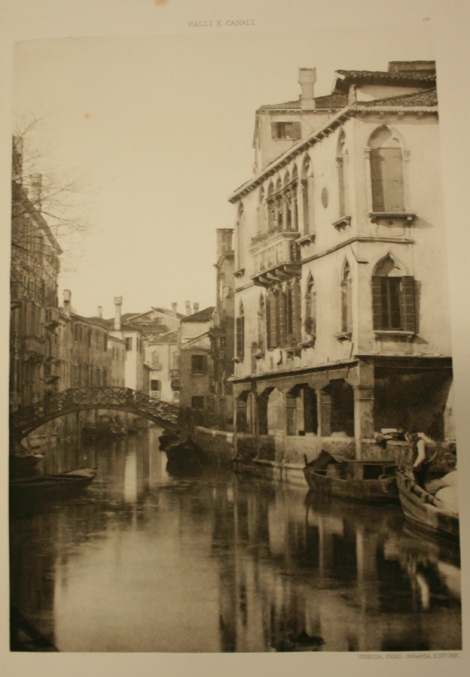Exposing the Photographic Book Collection: a summer amongst the stacks


Earlier this summer I was lucky enough to spend a few months writing catalogue entries for some of the works held in the new Photographic Books Collection. This was a wonderful job because I love everything about photobooks: from reading the texts and looking at the images, to feeling the paper and smelling the ink. You can trace the development of the photographic book through this collection from one of the very first books to contain photographs – William Henry Fox Talbot’s The Pencil of Nature (1844-1846) – to the most contemporary photobooks.

One of the collection’s joys is the broad interpretation given to the term ‘photographic book’. You can examine 19th century works about Chinese Imperial Palaces; Venetian canals; long-destroyed Scottish mansions; scientific expeditions to Tenerife; and pilgrimages to Mecca. In addition, there are holdings of early photographically-illustrated novels and poetry, enabling us to see photography used as an equivalent, rather than just an illustration, of a text.

The 20th and 21st century selection of photographic books is even more wide-ranging, and contains publications that attempt to fuse text and image, like Lance Sieveking’s and Francis Bruguière’s Beyond This Point (1929?) which features fascinating multiple-exposures and photographs of abstract paper cut-outs. There are also books containing abstract photographs created from a completely different motivation, such as Nuclear Physics in Photographs (1947), a scientific tome featuring abstract photographs taken through an electron microscope.

Many of the 19th century photographic books focus on documenting and categorising in a scientific, historical, ethnographic, social and/or colonial context. While justly celebrated works such as the multi-volume The People of India (1868-1875) and the intriguingly titled Tree and Serpent Worship (1868) are well worth examining, I was drawn to quite a different product of Britain’s colonial exploits – M.S. Craig’s Diary of a Trip to Egypt (1909?). This book contains 52 small photographic images, which the author states are intended “for the family circle” and “indulgent friends”. Neither the text nor images are of earth-shattering significance, yet the book gives an unusual insight into the travels of a genteel lady, through a discursive personal text and snapshots of the Pyramids and Sphinx; family members riding camels; and portraits of (understandably) grumpy-looking local attendants.


As noted elsewhere on this blog, the collection includes a cracking selection of books on Paris, a number of important inter-war works, and a first edition of Robert Frank’s Les américains (1958). The 1959 English-language edition of Frank’s most famous work first sparked my interest in photobooks, and it is wonderful to be able to examine the French and English editions side by side, particularly in order to see how their two very different approaches to the combining of text and image alter the material’s overall impression upon the reader/viewer. The Americans is so influential that the collection contains a huge volume about this photobook, which surpasses either edition in size and weight!

Another area of the collection that deserves highlighting is the range of photobooks intended as a form of protest. These publications include reprints of rare photobooks focused on struggles originating in Latin America, Algeria, Japan and Italy, all housed in The Protest Box; W. Eugene Smith and Aileen M. Smith’s Minamata (1975), based on the renowned photo-story published in Life magazine; and Agent Orange (2003) by Philip Jones Griffiths, compiled from images taken by the Magnum photographer during his regular visits to Vietnam and Cambodia in the years following the Vietnam War.

Finally, I want to draw attention to eight books by the celebrated contemporary artist Ed Ruscha. These brilliant photobooks “do exactly what it says on the tin”: in other words, the contents are summarised by the book’s title. For example, Every building on the Sunset Strip (c.1966) depicts precisely that. My personal favourite is Babycakes with weights (1970), which consists of a picture of a baby (with his weight written beneath) followed by images of different cakes, each captioned with its individual weight. The photography is absolutely deadpan, the title is literal and amusing, and even the cover fits the theme, with peachy-pink felt lettering, all bound up with a ribbon.

For me, the only downside of working with the Photographic Books Collection was that it was far too engrossing, and as a result I was unable to complete all the catalogue entries for the collection. One book still tantalises me with its slightly worrying title – Dr Peter Landow’s Nature and culture: Women: 120 photographs of various nationalities (1928). I surmise that this book must be either highly entertaining or quite offensive (possibly both). It is at the top of my list of works to consult the next time that I am in Special Collections.
–Liz Shannon
Visiting Photobook Researcher
Finally I get to see what's in Peter Landow's book! Thanks Daryl!